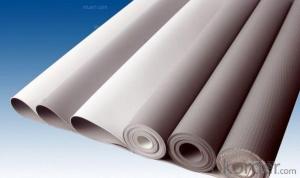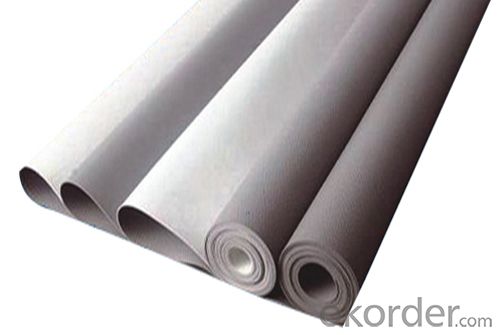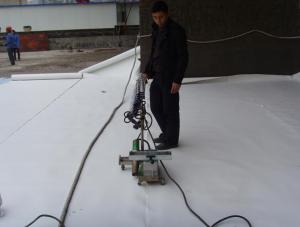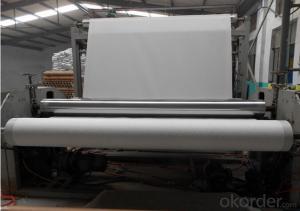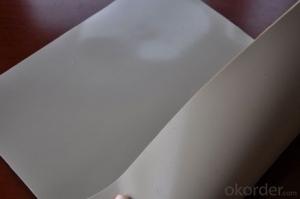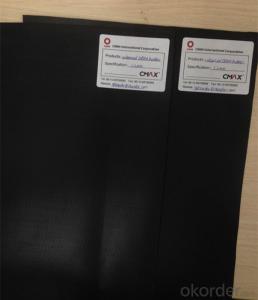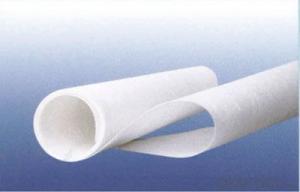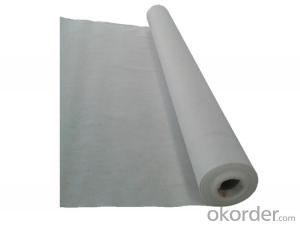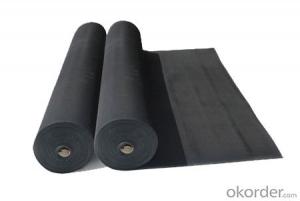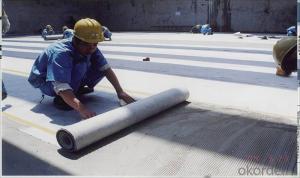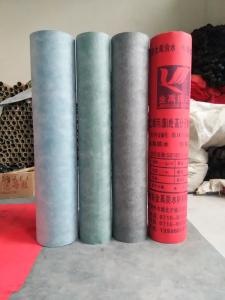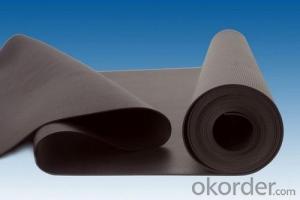Ethylene Propylene Diene Monomer Waterproofing Membrane
- Loading Port:
- China main port
- Payment Terms:
- TT OR LC
- Min Order Qty:
- 10000 m²
- Supply Capability:
- 300000 m²/month
OKorder Service Pledge
OKorder Financial Service
You Might Also Like
1.Structure of EDPM Waterproofing Membrane Description:
EPDM waterproofing membrane (hereinafter referred to as EPDM coiled material) system for EPDM mixed with just the right amount of butyl rubber, curing agent, accelerator, softener and reinforcing agent, end spacing refine, pull piece of filtering, extrusion molding process. Due to the molecular structure of epdm on the main chain of double bond, as a result, when it had been hit by ozone, ultraviolet radiation, the role of damp and hot, is not easy to break on the primary key, so it has excellent weather resistance, aging resistance, and high tensile strength, elongation, scaling or cracking at the base of strong adaptability, value, light weight, use temperature scope width (within the range - 40 ~ + 80 ℃ can use for a long time), is a kind of efficient waterproof material. It can also be cold construction, convenient operation, reducing environmental pollution, improve workers' working conditions.
2.Main Features of EDPM Waterproofing Membrane:
Excellent weather resistance and aging resistance
High tensile strength and high elongation break
High value,light weight
Easy operation, reducing environmental pollution
3.Specification of EDPM Waterproofing Membrane:
| Item | ||||
| Tensile Strength(Mpa) | 7.5 | Shrinkage ≤ | 4 | |
Elongation at failure (%) | 450 | |||
| Tear strength(KN/M) | 25 | |||
Low temperature bending(℃) ≤ | 40 |
4.EDPM Waterproofing Membrane Images:
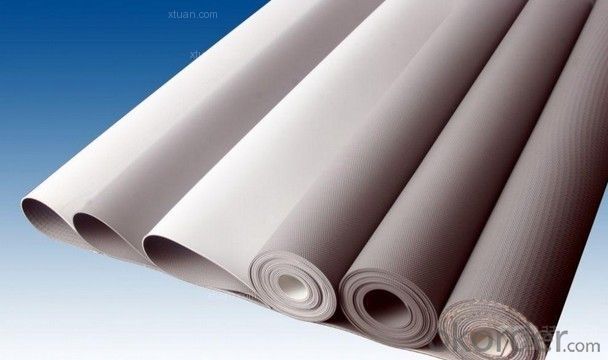
- Q: Is a waterproofing membrane compatible with different types of adhesives?
- Certainly, various types of adhesives typically work well with a waterproofing membrane. Nevertheless, it is crucial to verify that the adhesive chosen is appropriate for the specific waterproofing membrane in use. The compatibility of different adhesives with various waterproofing membranes can vary due to differences in composition and surface properties. Seeking advice from the manufacturer or supplier of both the waterproofing membrane and adhesive is advised to ascertain their compatibility and suitability for the desired application. Moreover, adhering to the manufacturer's instructions and guidelines for both the membrane and adhesive will guarantee a proper installation and long-lasting effectiveness.
- Q: Can a waterproofing membrane be used for train platforms?
- Yes, a waterproofing membrane can be used for train platforms. Train platforms are exposed to various weather conditions, including rain and snow, which can cause water damage and deterioration over time. By installing a waterproofing membrane on the surface of the train platform, it creates a protective barrier that prevents water from seeping through and causing damage to the underlying structure. This helps to extend the lifespan of the platform, reduce maintenance costs, and ensure the safety of passengers and personnel. Additionally, a waterproofing membrane can also help to prevent the growth of mold and mildew, which can be detrimental to the health of individuals using the train platform. Overall, using a waterproofing membrane on train platforms is a practical and effective solution to protect against water damage and maintain the longevity of the infrastructure.
- Q: Can a waterproofing membrane be used for residential buildings or homes?
- Yes, a waterproofing membrane can be used for residential buildings or homes. It is commonly used in basements, bathrooms, and other areas prone to water damage to prevent moisture infiltration and protect the structure from potential water leaks or flooding.
- Q: Can a waterproofing membrane be used on tunnels with architectural features?
- Indeed, tunnels with architectural features can benefit from the application of a waterproofing membrane. Such membranes possess versatility, enabling their usage on different structures, including tunnels with architectural elements. Their primary purpose is to establish a protective barrier against water infiltration, consequently safeguarding the structure against moisture-related harm. Regardless of the tunnel's unique architectural components, such as curves, arches, or decorative embellishments, a tailored waterproofing membrane can be tailored and implemented to ensure optimal water resistance. Therefore, it is imperative to seek guidance from a proficient waterproofing specialist experienced in working with tunnels and architectural features. They will assist in determining the most suitable membrane system for the specific project prerequisites.
- Q: Can a waterproofing membrane be used on elevator shafts?
- Yes, a waterproofing membrane can be used on elevator shafts. Elevator shafts are prone to water infiltration, especially in areas where the water table is high or during heavy rainstorms. Installing a waterproofing membrane on the walls and floor of the elevator shaft can provide an effective barrier against water penetration. The membrane is typically made of a durable material such as bitumen or rubberized asphalt, which is applied in multiple layers to ensure maximum protection. It acts as a waterproof barrier, preventing water from seeping into the shaft and causing damage to the elevator equipment or the building structure. Additionally, the waterproofing membrane also helps to control moisture and condensation, which can lead to mold growth and other issues. Proper installation and maintenance of the membrane are crucial to ensure its long-term effectiveness in keeping the elevator shaft dry and protected.
- Q: Can waterproofing membranes be used on metal roofs?
- Yes, waterproofing membranes can be used on metal roofs. These membranes are designed to create a protective barrier against water infiltration, and they can be applied to various roofing materials, including metal. Waterproofing membranes provide an effective solution to prevent leaks and extend the lifespan of metal roofs.
- Q: Can a waterproofing membrane be used for podium decks or plaza areas?
- Yes, a waterproofing membrane can be used for podium decks or plaza areas. Waterproofing membranes are commonly used in construction to prevent water penetration and protect the underlying structure from moisture damage. In outdoor areas like podium decks or plaza areas, where exposure to rain or other forms of water is common, a waterproofing membrane can provide an effective barrier against water infiltration and help maintain the integrity of the deck or plaza surface.
- Q: Can waterproofing membranes be used on loading docks?
- Indeed, loading docks can make use of waterproofing membranes. These membranes have been specifically crafted to create a shield against water infiltration, rendering them appropriate for a range of uses, including loading docks. The installation of waterproofing membranes on loading docks serves to thwart water damage and leakage into the underlying framework, thus safeguarding the dock's integrity and durability. Moreover, the utilization of waterproofing membranes can contribute to increased safety by minimizing the potential for accidents resulting from slippery surfaces on loading docks.
- Q: Can a waterproofing membrane be used in conjunction with other waterproofing products?
- Yes, a waterproofing membrane can be used in conjunction with other waterproofing products. In fact, it is common practice to use multiple waterproofing methods together to provide enhanced protection against water damage. For example, a waterproofing membrane can be used as a primary waterproofing layer, and then complemented with other products such as sealants, coatings, or drainage systems for added durability and performance. The combination of these products can help create a more robust and comprehensive waterproofing system, ensuring maximum protection against water intrusion and preventing potential leaks or moisture-related issues.
- Q: Are waterproofing membranes resistant to alkalis?
- Waterproofing membranes, in general, exhibit resistance to alkalis. Alkalis, substances with high pH levels like sodium hydroxide or potassium hydroxide, can be present in various construction materials including concrete. The main purpose of waterproofing membranes is to create a protective barrier against water and other potentially harmful substances. They are typically manufactured using materials such as modified bitumen, PVC, or EPDM, which possess excellent alkali resistance. This resistance ensures that the waterproofing membrane remains intact and efficient even when exposed to alkaline substances. When dealing with materials or environments containing high levels of alkalis, it is crucial to choose a waterproofing membrane specifically designed for alkali resistance.
Send your message to us
Ethylene Propylene Diene Monomer Waterproofing Membrane
- Loading Port:
- China main port
- Payment Terms:
- TT OR LC
- Min Order Qty:
- 10000 m²
- Supply Capability:
- 300000 m²/month
OKorder Service Pledge
OKorder Financial Service
Similar products
Hot products
Hot Searches
Related keywords
